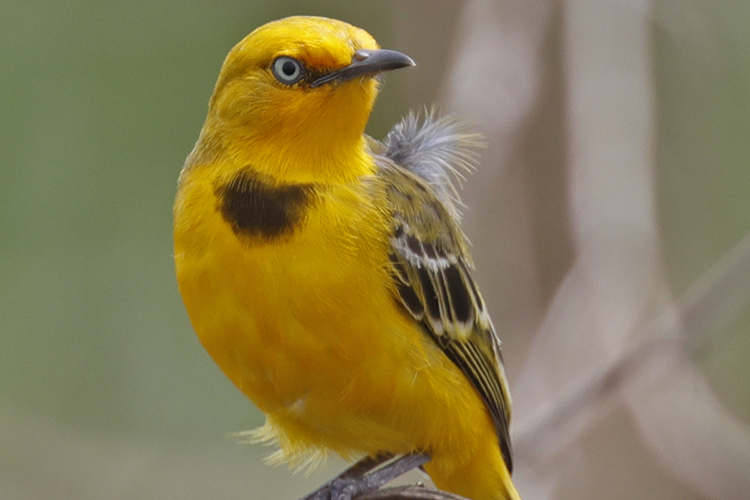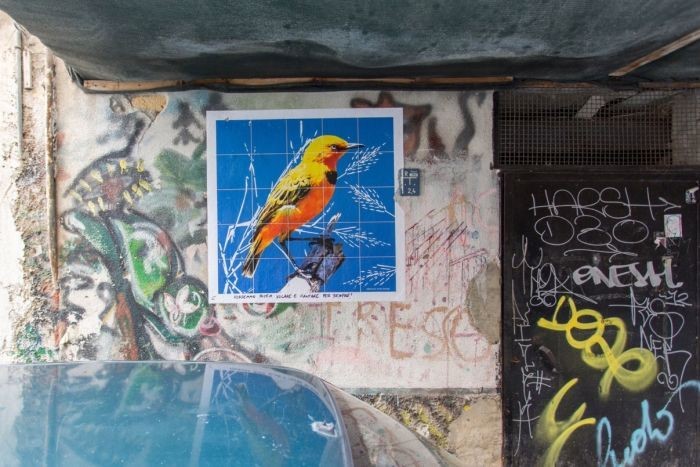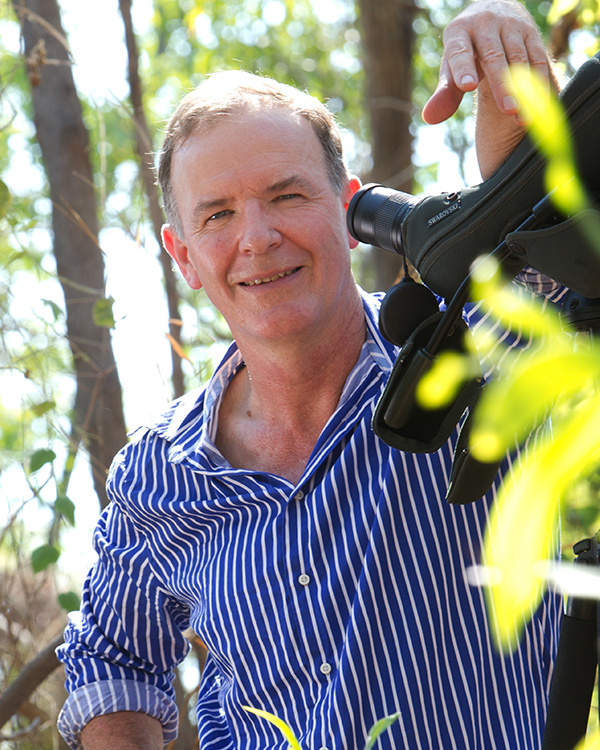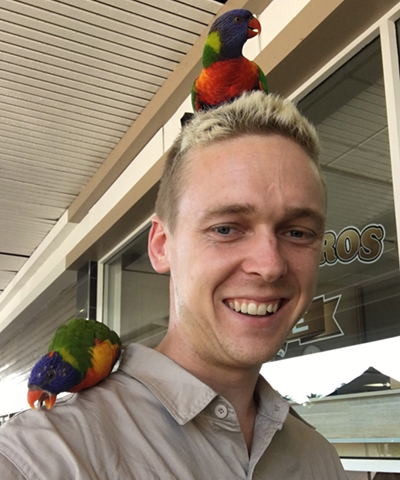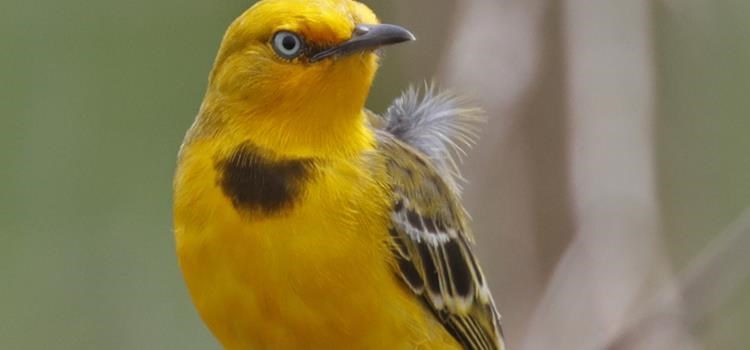
Project: 6.2.3
The conservation ecology of the Alligator Rivers yellow chat
Project Leaders: Stephen Garnett , Robin Leppitt
Research in Brief
The Alligator Rivers yellow chat is a small, bright yellow insectivorous subspecies of bird living on the floodplains of several major rivers in the ‘Top End’ of the Northern Territory including within and nearby Kakadu National Park. Despite its listing as Endangered, little research has been conducted on the bird and its habitat requirements and major threats are not well understood.
This project aims to increase the ecological knowledge we have of the Alligator Rivers yellow chat in order to improve its conservation management.
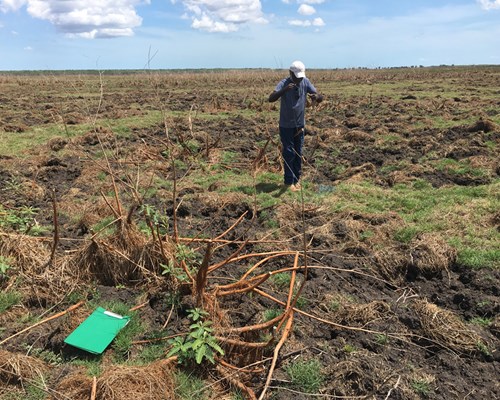 Tiwi man and local Kapalga resident Roy Tipaloura helping researcher Robin Leppitt to find and access floodplain habitat areas. Photo: Robin Leppitt
Tiwi man and local Kapalga resident Roy Tipaloura helping researcher Robin Leppitt to find and access floodplain habitat areas. Photo: Robin Leppitt
Why is the research needed?
Conservation efforts are most successful when land managers have accurate and current information on the species and habitat which they manage. Key ecological parameters include abundance, distribution, habitat requirements, breeding ecology and major threats to a species, community or habitat. Changed fire regimes, climate change, feral animals such as pigs, buffalo and horses and invasive weeds such as gamba grass and mimosa have been identified as potential threats to the the Alligator Rivers yellow chat (Epthianura crocea tunneyi) but we don’t yet know whether they are in fact threats or what to do about them if they are.
When the biology of a species is unknown or poorly understood, their conservation becomes far more difficult.
Despite being listed at both national and state level as Endangered, a lack of research has resulted in
conservation efforts for the chat being constrained by a lack of knowledge. This project aims to provide the necessary understandings to guide effective conservation efforts.
How will the research help?
The aim of this project is to understand the causes and consequences of rarity in the Alligator Rivers yellow chat in order to improve its conservation management. By exploring the factors that influence why chats choose one patch of habitat over another, we will identify what the perfect patch of chat habitat looks like, what it is made up of and how we can protect and encourage that habitat to flourish. By testing which threats are most dangerous not only to the chats but also to the chat habitat we have identified, we can prioritise which threats are most in need of mitigation.
Whether that be the controlling of feral pigs, buffalo or cats, the reduction of weeds like Mimosa pigra and para grass, or the frequency and intensity of fire, this project will be the first to provide scientific evidence to indicate which is the most threatening.
Additionally, we will develop a monitoring program that, in consultation with Traditional Owners and parks staff, will be both cost- and time-effective and provide an accurate estimation of yellow chat numbers. This will be crucial to ensuring that any management actions that are implemented have the desired effect on both chat habitat and numbers.
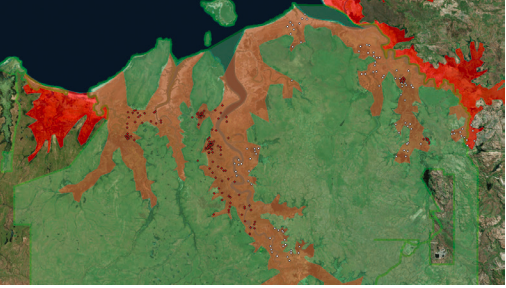
 The red areas on this map are floodplains in Kakadu, the key habitat of Yellow Chats. The red and white dots indicate potential sampling sites on the West, South and East Alligator Rivers.
The red areas on this map are floodplains in Kakadu, the key habitat of Yellow Chats. The red and white dots indicate potential sampling sites on the West, South and East Alligator Rivers.
What research activities are being undertaken?
This project will involve surveying vast tracts of the floodplain habitat the yellow chat calls home, which is also the country of several Traditional Owner groups from the Kakadu region.
After obtaining permission to work on this country, and discussing the issues with the Traditional Owners, the team will survey both randomly and in areas where chats have been seen recently, covering as much ground as possible in the short window that the late dry season provides for safe passage around this otherwise very wet and boggy environment. At each survey site, we look for and count chats as well as record habitat structure and make-up. At the request of the Traditional Owners, who are part of the research team when available, we also note the presence and evidence of feral animals as well as the type and extent of any weeds.
Alongside these site surveys are behavioural observations of any yellow chats located, noting the time they allocate to different activities (such as foraging, preening, flying), as well as recording the types of insects they are eating, where possible.
We have also been capturing yellow chats using mist-nets, colour banding individuals to allow for their future identification, and taking some feathers for genetic analysis to add to the mitochondrial phylogeny (i.e. their evolutionary tree) of chats.
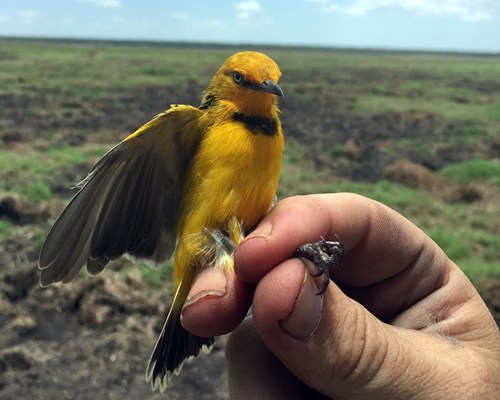 Birds have been caught with nets to allow their legs to be banded. Banding allows individual birds to be identified and for population size to be estimated in surveys. Photo: Robin Leppit
Birds have been caught with nets to allow their legs to be banded. Banding allows individual birds to be identified and for population size to be estimated in surveys. Photo: Robin Leppit
Who is involved?
This project is being led by researchers from Charles Darwin University, who are collaborating closely with the Northern Territory Government scientists, and Kakadu National Park Traditional Owners and park staff. The research team are also collaborating with the Northern Territory Parks and Wildlife park rangers at Fogg Dam and some cattle station owners on the Mary River Floodplain.
Where is the research happening?
This research is occurring on the floodplains of the Adelaide, Mary, South Alligator and East Alligator rivers, although primarily on the latter two, which are in Kakadu National Park.
When is the research happening?
This research will run for four years from mid-2016 until 2020.
Further information
For more information please contact Robin Leppitt - robin.leppitt@cdu.edu.au
Top image: A male Alligator Rivers yellow chat. Photo: Keith Lightbody
